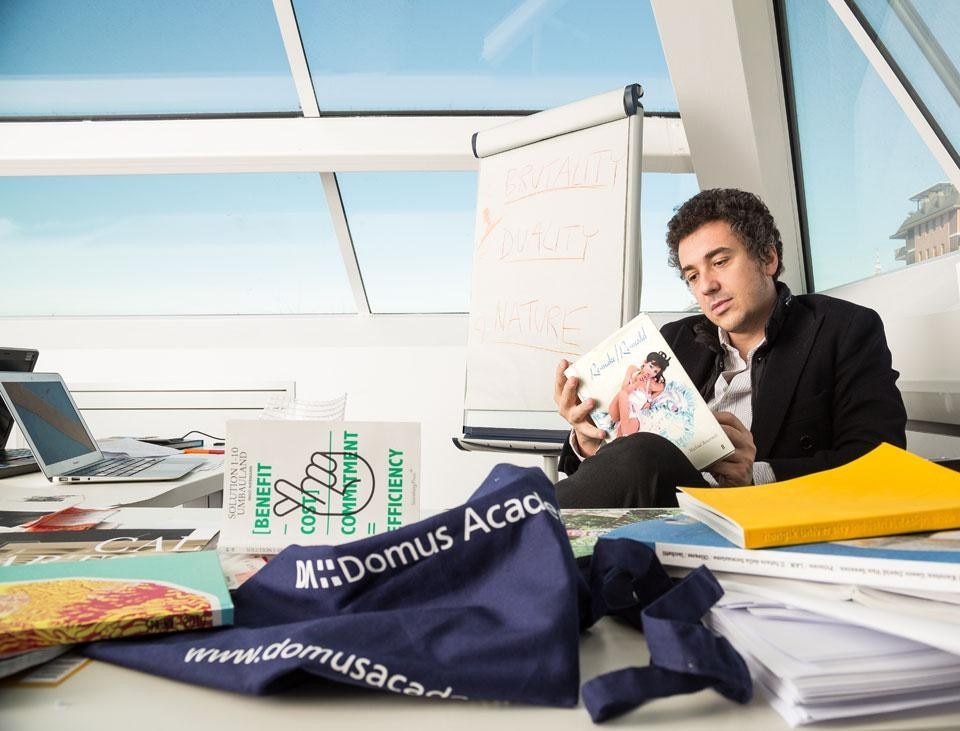This article was originally published in Domus 967 / March 2013
Are design schools finished? The answer is a
resounding, "No!" In a melting pot of radicalism and
optimism, design schools are at the start of a new
beginning. Many "creative" institutions won't survive
the onslaught of self-produced knowledge, an
obvious consequence of the digital revolution. At
any rate, if such creative schools do want to survive,
nothing less than giant ambitions will suffice. For
these institutions, the only hope lies in their ability to
offer a transformative experience, both educational
and human: how to spend time shut up in a house
where the shelves contain all the books published by
Gallimard; how to take ten aeroplane trips of different
lengths with individuals who live by the maxim "only
connect"; how to take part in a seminar where something
is really discovered. Here are some ideas for the
direction that a school of design, fashion or architecture
must take to survive, prosper, invent new forms
and be, in technical terms, an institution that produces
public knowledge. Domus Academy already offers
its students an effective, specialised experience; it is
already a school with a global reputation for excellence,
and not only thanks to its extraordinary history.
But since we can and must set our sights still higher,
here are 14 ideas for fine-tuning the venture.
1. A Wunderkammer of ideas
"Cabinets of curiosities" do not just belong to memory.
They still exist in the minds of certain authors, from
Lawrence Weschler to Geoff Manaugh. In a world
defined by dizzying complexity and a sense of accessibility
that can induce crippling depression, a thirst
for knowledge should be an asset that creates wonder.
And the creation of wonder is a political gesture, in Italy
and Europe, both in and beyond the world of design.
2. A red carpet for the self-taught
What's the use of a school attended solely by self-taught
students? As Andrea Branzi claimed in a conversation
with Angela Rui, it would be the best school
in the world. Those who don't know how to learn by
themselves don't know how to learn with others,
and they can't teach those tasked with guiding the
learning process. There's no pleasure in guiding this
process if nothing new is learnt at the end of it.
3. The fuller
A fuller is a feature of blades. Schools must assault the
near future to have an impact later on, at a time when
things will have gone the only way they could go, the
time of fatalistic necessity — the time of design.
14 Do's for a Fuller Domus Academy
The vision, ambition and plans for the new Domus Academy — part of the LIU group — as explained by its new dean Gianluigi Ricuperati, appointed to bring the Milanese design school, and its spirit, into the 21st century.

View Article details
- Gianluigi Ricuperati,Italo Rota
- 08 March 2013
- Milan

4. Buckminster Fuller
Richard Buckminster Fuller died 30 years ago, on 1
July 1983. Perhaps more than any other, his mind
united the qualities of architect, inventor, humanist
and idealist in a varied body of work. This first year of
the new Domus Academy should be dedicated to this
exemplary and enlightening figure, starting with
the fine book Becoming Bucky Fuller (2009), which
describes how a young architect — who was also hungry
for success in pre-1929 America — became himself
via personal tragedies, a year of isolation, and
changes of direction. Isn't that how self-education
works? As Robert Frost wrote: "Two roads diverged
in a wood, and I, I took the one less traveled by."
5. A Fuller Academy
Increasingly, students find the information and
knowledge they need online for free. The reason for
enrolling at such an institution is not (solely) to consolidate
and expand this baggage of ideas and practices,
but to have face-to-face contact and gain an experience
that is charged with far more emotion than we would
care to admit. For teachers, Roland Barthes's A Lover's
Discourse: Fragments could prove more fertile than certain
deadpan texts in vogue in polytechnics.
6. Invent new ways to work
In the here and now — at this latitude, in the aftermath
of the digital revolution and bogged down in a
kind of structural depression — we need to invent and
assign new professions involved with the way we
design objects (for example, in providing elegant and
functional things for the ever-growing population of
active, dynamic senior citizens). This approach must
also apply to the way we run our cities and the way
we produce and distribute food. No other project is
worth undertaking.
7. The Atelier
Italo Rota has often insisted that anyone teaching in
this kind of school can and must propose at least one
concept, image or object that will foster a recirculation
of silent learning. The mute presence of accumulated
experience is a matchless resource, a debt-less debt.
8. The Atelier of the mistake
Design and business schools never teach students
enough about learning from their mistakes. A school
should teach them to avoid errors, but also assign a
surplus of "care" to each failing, even the smallest.
A school based on this simple, insuperable principle
may perhaps offer students the most fruitful technical
and existential experience. Examining, reconstructing
and repairing the mistakes, with due emotional
attention and appropriate respect, is exactly
what a good teacher should do.
9. Money Design / Social Design
A school capable of revitalising ways of engaging
with the design and fashion markets could improve
the quality of the entire system in the long term. The
same applies to planning within the non-profit and
social intervention sphere.
10. Designed space as a literary genre
If you write well, you think well. Recently, Rem
Koolhaas suggested that he was an amateur in architecture,
sociology and anthropology. Instead, he considers
himself a professional writer. Teaching designers
of the future to write will not contribute directly
to the quality of their work. It will do this indirectly,
but in a world where indirect relationships are much
more significant than clear-cut relationships.
11. The multidisciplinary code
Like any "advanced" school, Domus Academy is an
organism that cannot ignore the existence of a strong
theoretical impulse. Why not build here, in the place
where Pierre Restany, Alessandro Mendini and
Gianfranco Ferrè outlined their own complex journeys
in the 1980s, a locus of research into the codes of a multidisciplinary
approach, studying how the different
disciplines can truly engage in an effective and down-to-
earth dialogue?
12. Extreme Weather Design
Inevitably, in the 21st century extreme weather events
will occur with a frequency that was previously unimaginable.
There is an urgent need to work with students
on landscapes, objects and clothes that are suited
to coexistence in drastic conditions.
13. A school must produce images
Throughout history, there has never been a school
that has not produced semantic objects, images and
icons. The school must become a cultural player in the
full sense of the term. The teaching, which focuses
on students and their development, must represent
an opportunity to generate advanced and accessible
cultural products, observing Loewy's old "MAYA"
principle: Most Advanced Yet Acceptable.
14. Italian Design
Domus Academy is Italian design, which is why
students from all around the world enrol. But what
is Italian design? It's difficult and risky to hazard a
concise answer. For my part, I believe that, among
other things, Italian design implies an impressive
production district. Perhaps, if the school tightens
and improves its connections with that district—
with companies, skills and people—our answer can
be simpler and more brazen. What is Italian design?
Domus Academy. Gianluigi Ricuperati, writer, dean of Domus Academy
A small Utopia
Imagining the present and future of a prestigious
school does not involve devising a revolution so much
as developing a process of accelerated reflection.
The school today has difficulty pursuing the
different fields of knowledge, in terms of
transcribing, absorbing and transmitting them.
Plenty of young people try or flirt with the idea of
teaching themselves. Many of today's successful
projects are created by individuals with a wide
range of skills, who have an engaging and nuanced
understanding of life and humanity. Artists
do shops and architecture, while architects are
cooks and designers—everyone does everything.
A school needs to tackle a system in crisis that is
struggling to come up with the tools of self-analysis.
Architects and town planners, like designers of
objects and systems, cannot shy away from a radical
rethinking. It isn't the "crisis" in generic terms that
demands this. Rather, it seems to me that it's the
"earth", "time" and the "weather", environmentally,
historically and atmospherically speaking. At this
point I think we can allow ourselves a "small utopia".
To head a design institution such as ours, we chose
a non-designer, because we believe the point isn't
so much about disciplinary background. Rather, it's
about the ability to create a vision, as well as a certain
generational proximity to the students, who are the
focus of the Domus Academy and naba experience.
The process that led to this choice involved
consulting a range of people, from creatives at
innovative businesses to gurus of the intangible
world and wise-old teachers, to understand what
type of person could lead Domus Academy and its
spirit into the 21st century. This figure had to be
capable of communicating what we want to do,
what we are doing and what we have done, but also
able to "learn from their mistakes", a capacity that is
more indispensable today than ever. Teaching also
means learning a lot from the students.
In my opinion, an ideal point of re-departure can
be found in the manifesto of ideas that Gianluigi
has drafted, after long weeks of discussions with
me, Alberto Bonisoli, LIADE's chief academic officer,
and Marc Ledermann, CEO of Laureate Design. It
commits all of us to share knowledge, engage with
society and take part in the construction of a world
that requires commitment from us all. Italo Rota, scientific director of LIADE (NABA and Domus Academy)